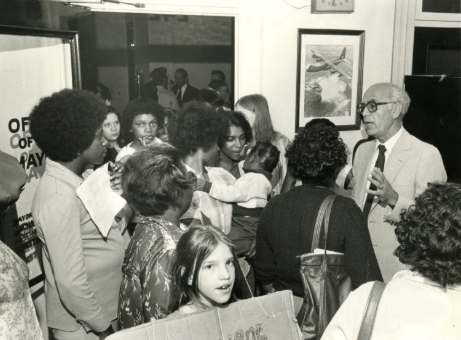
Black Activism in Niagara
Throughout history, the Black community in Niagara Falls has led activist movements for equal rights.
Niagara Falls has always been a place where ordinary people have done extraordinary things. By actively leading resistance movements and banding together to form citizen-led activist crusades, the city’s Black residents have left an indelible mark on history.
Located on the banks of the Niagara River, the prestigious Cataract House employed an elite Black waitstaff in the nineteenth century. Many of these waiters came from states with legalized slavery. Despite great personal risks—including fines, imprisonment, and enslavement—they established an activist network to aid enslaved people seeking freedom in Canada.
Before and during the Civil War, the waiters helped freedom seekers flee the hotel and ferried them across the Niagara River to Canada. These missions were often led by head waiter John Morrison and waiter Lewis H.F. Hamilton. In cases like Patrick Sneed and a woman named Martha, the waiters took collective action by physically barring enslavers and law enforcement from pursuing their targets.
In the 1950s and 1960s, Black residents participated in local and national demonstrations, protests, and marches as part of the Civil Rights Movement. Individuals like Bloneva Bond, Doris W. Jones, Frederick Brown, and Reverend Edgar L. Huff emerged as community leaders who fought against discrimination in areas like employment, schools, and housing. Their legacies live on today in the form of a renamed primary school (Bond), a community center (Jones), a boulevard (Brown), and a rededicated bridge (Huff).
In the late 1970s, Black women became prominent activists during the Love Canal environmental disaster. From 1942–1953, Hooker Chemical Corporation dumped over 20,000 tons of toxic chemicals into the canal. The chemicals had slowly leached into the groundwater and basements of nearby homes and apartments, wreaking havoc on the environment and residents’ health.
When white residents formed the Love Canal Homeowners Association (LCHA), they neglected the residents of Griffon Manor—a predominantly Black housing project directly across the street from Love Canal. This was primarily due to long-simmering racial tensions and the misconception that, as renters, the Griffon Manor residents did not need the same relocation assistance as the homeowners.
Undaunted, the Griffon Manor residents established the Concerned Love Canal Renters Association (CLCRA) to counter the racism and classism of not only the homeowners but also the politicians, bureaucrats, news media, and state researchers involved in the investigation. Although these same entities often overlooked their activism, Black women like Agnes Jones, Vera Starks, Elene Thornton, and Sarah Herbert led efforts to advocate for an evacuation plan and scientific testing at Griffon Manor. They circulated petitions, threatened legal action, and enlisted the support of clergy, politicians, and the NAACP. Despite various obstacles and the indifference of state public health officials, the activists eventually prevailed, and Griffon Manor was evacuated safely.
For more inspiring stories about African Americans in Niagara Falls, visit discoverniagara.org
Niagara Falls National Heritage Area

